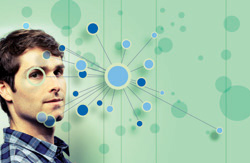Visual law services are worth a thousand words—and big money

Daniel Lewis: “What we’re trying to do is make
the process easier, more intuitive,
more thorough.” Photo of Daniel Lewis by Tony
Avelar, illustration by Stephen Webster.
Daniel Lewis was midway through his second year at Stanford Law School when he became convinced there was a better way to do legal research.
The thought came to him while doing work for a nonprofit in 2011. He was trying to understand where his issue fit within a broad group of cases his research had found. In his mind he pictured a view of his issue triangulated against the most important cases at the center and all the other, less important cases circled around them.
“It took shape in my mind as sort of a visual process of trying to figure out where on this map I needed to locate myself and what the other cases were that I needed to be aware of,” he recalls. As he discussed that idea with other students, he discovered many of them shared his approach of trying to contextualize their research visually.
With the rough contours forming in his mind of a better legal research mousetrap, Lewis took the idea to various people at Stanford, most influentially Jeffrey Heer, a computer science professor then at Stanford (and now at the University of Washington) and an expert in data visualization. Heer introduced Lewis to computer science research on understanding social connections and visualizing data sets that helped him begin to crystallize his idea.
By the beginning of his third year, Lewis had teamed up with friend and classmate Nicholas Reed. That fall the pair took a course in venture capital, and in the spring they enrolled in an intensive LaunchPad course in product design at Stanford’s Hasso Plattner Institute of Design, known as the D.school. Before year’s end they had a business plan, and just two weeks before graduation their plan placed second in a universitywide business plan competition.
By their June 16, 2012, graduation day, Lewis and Reed had investors knocking at their doors. A week after graduation they went full bore into raising funds; and a month later, just a few days before they were to take the bar exam, they closed an initial round of financing of $1.1 million.
Ravel, their legal research alternative, was born.
Click here to read the rest of “Vision Quest” from the May issue of the ABA Journal.



